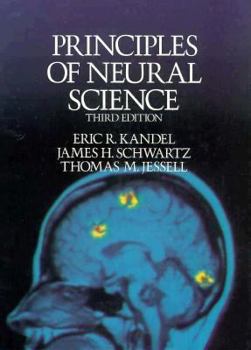Principles of Neural Science
Select Format
Select Condition 
Book Overview
Now updated: the definitive neuroscience resource from Eric R. Kandel, MD (winner of the Nobel Prize in 2000); James H. Schwartz, MD, PhD; Thomas M. Jessell, PhD; Steven A. Siegelbaum, PhD; and A. J.... This description may be from another edition of this product.
Format:Hardcover
Language:English
ISBN:0838580343
ISBN13:9780838580349
Release Date:July 1996
Publisher:McGraw-Hill/Appleton & Lange
Length:1135 Pages
Weight:6.75 lbs.
Dimensions:1.9" x 8.7" x 11.3"
Customer Reviews
5 ratings
Excellent reference, extremely comprehensive!
Published by Thriftbooks.com User , 18 years ago
Don't be deceived by the size of this book--Although it probably weighs more than I do, I have to say that kandel et.al, present the information in a clear, extremely comprehensible manner with a good deal of interesting experiments, clinical studies, and graphs/images to help illustrate the concepts discussed. Although this book is essentially meant for graduate students, it is highly accessible to undergrads and I am tempted to say anyone else, regardless of their science background. The table of contents and the index also principles of neural science a GREAT reference book. This should definately be a companion to any college (or above) level neuroscience course! HIGHLY RECOMMENDED!
Introductory & Intermediate Neurosciences
Published by Thriftbooks.com User , 19 years ago
I used this in medical school, then graduate school, finding the length and quality improve with succeeding editions of the volume. Very well known chapter editors create a 'Scientific American-like' view of the Basic Neurosciences. This book is grossly inadequate if you want to pass medical and graduate school exams. It's like a "candy-coated" atlas of neuroscience. There are not many rigorous equations to learn in the book. For that you will need From Neuron to Brain or even a higher book such as Theoretical Neuroscience. The strength of this book is the beautiful color illustrations. Its weakness is that it does not cover "hard-core" electrophysiology. Ohm's Law and the cable theory of the squid giant axon are covered, but where is Heisenberg-James' Theory of the quantum vesicle exocytosis, 'HJ' Theory of the Mind, and Boolean algebra. No mention of these ideas. You would have to go to Sir John Eccles' The Self & Control of its Brain, as well as Henry Stapps Mind, Brain, & Quantum Mechanics for further expansion on such theories. Also, where is Bayes Theorem and a discussion of probabilistic Populations of Neurons. Entropy is not discussed. A useful reference is Information Theory & the Brain by Baddeley for this. Ballistic, and Biofeedback are not discussed. Refer to Roger Carpenters' Movements of the Eyes & Neurophysiology 4th ed. Magnetic Stimulation and fMRI are alluded to but not incorporated as valid tools in the study of the Nervous System. Alan Kingstone with UBC, Vancouver, Canada has written a good reference on this. I have not really used this book since graduate school. This text is a very good overview of Neuroscience ranging from cell biology of neurons, ion channel physiology, to Movement Control, to Cognition & Memory. Phenomena like LTP & LTD have their own individual chapters. I still own this book and will keep it as a nice reference even though I do not refer much to it in my daily work.
Good overview of neurobiology
Published by Thriftbooks.com User , 23 years ago
This book provides a comprehensive overview of neurobiology. While it originated as 65 lectures given by faculty at the College of Physicians and Surgeons of Columbia University, it is very readable, and may be suitable for the motivated general reader.
essential text
Published by Thriftbooks.com User , 23 years ago
This text (or perhaps an earlier edition) was a lifeline for me for many years as a undergraduate and postgraduate student of psychology (with semester units in neurophysiology and neuroanatomy). It was completely perfect in that it covers the fundamentals of neuroscience in slightly more detail than one needs (unlike most textbooks which always seem to do everything in slightly less detail). Just like you always feel that you have to be clutching a calculator when you're studying physics, so you need this for any kind of neural science studying. It has clear, lavish pictures and everything is thorough and easy to understand.And, oh boy, what a Book! You really feel that you've got something for your money. It's hefty, it's intellectual, and it looks damned good on the bookshelves. The paper is glossy, everything's set out well, and you feel good every time you refer to it.When I was a student, my general principle was to BUY NO TEXTBOOKS, and this one was very expensive for me at the time, but it was worth it. Probably the most valuable book I had in all my 8 years of formal studying. It contained everything I needed in terms of information on this topic, and on the rare occasions when I had to go further into something, there were very useful references at the end of every chapter. I strongly recommend it. You'll use it for years, and when it's time to move on, it'll be easy to sell.
Neuroscience classic
Published by Thriftbooks.com User , 24 years ago
I read this book in medical school. Although I would agree that it is probably to basic science oriented for a medical school neuroscience course, it was enjoyable, thorough, and inspirational. There are few books in my life that took as complex a topic as how the brain works and made it comprehensible. It is not a crib sheet for passing medical school exams. It is the first book I would recommend for anyone seriously interested in an understanding of the brain, sensory processes, etc... For anyone for whom a fundamental grounding in neuroscience is important this is the book.





